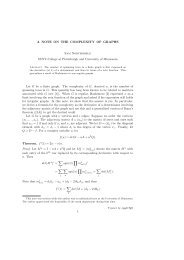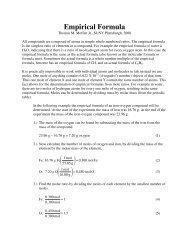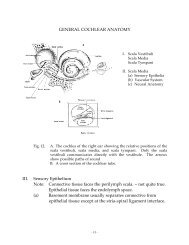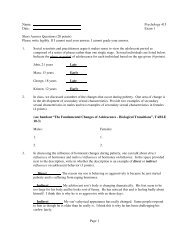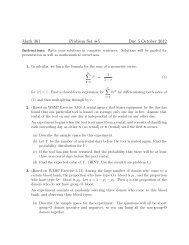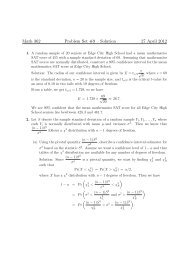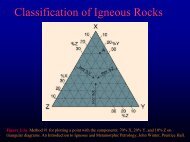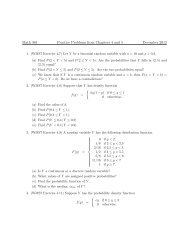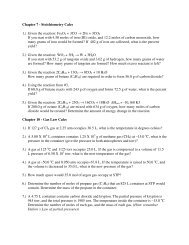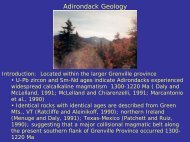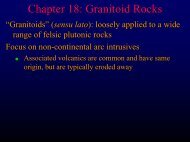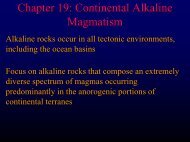Chapter 22: Classification of Metamorphic Rocks - Faculty web pages
Chapter 22: Classification of Metamorphic Rocks - Faculty web pages
Chapter 22: Classification of Metamorphic Rocks - Faculty web pages
Create successful ePaper yourself
Turn your PDF publications into a flip-book with our unique Google optimized e-Paper software.
<strong>Chapter</strong> <strong>22</strong>: A <strong>Classification</strong> <strong>of</strong><br />
<strong>Metamorphic</strong> <strong>Rocks</strong><br />
<strong>Metamorphic</strong> rocks are classified on the basis <strong>of</strong><br />
texture and composition (either mineralogical or<br />
chemical)<br />
Unlike igneous rocks, metamorphic rock names<br />
are surprisingly simple and flexible
<strong>Chapter</strong> <strong>22</strong>: Foliated<br />
<strong>Metamorphic</strong> <strong>Rocks</strong><br />
Foliation: any planar fabric element; penetrative,<br />
parallel distribution <strong>of</strong> minerals<br />
Lineation: any linear fabric elements; alignment <strong>of</strong><br />
linear elements in rock<br />
Cleavage<br />
the property <strong>of</strong> a rock to split along a regular set<br />
<strong>of</strong> sub-parallel, closely-spaced spaced planes
Schistosity<br />
<br />
<br />
<strong>Chapter</strong> <strong>22</strong>: Foliated<br />
<strong>Metamorphic</strong> <strong>Rocks</strong><br />
Planar orientation <strong>of</strong> platy minerals typically sheet<br />
silicates<br />
Aligned minerals are coarse grained enough to see<br />
with the unaided eye
Gneissic layering<br />
<br />
<br />
<strong>Chapter</strong> <strong>22</strong>: Foliated<br />
<strong>Metamorphic</strong> <strong>Rocks</strong><br />
Alternation <strong>of</strong> mineralogically distinct layers such as<br />
micaceous and quartzo-feldspathic<br />
layers<br />
Gneisses are generally coarse-grained
<strong>Chapter</strong> <strong>22</strong>: Foliated<br />
<strong>Metamorphic</strong> <strong>Rocks</strong><br />
Slate: compact, very finegrained,<br />
metamorphic<br />
rock with a welldeveloped<br />
cleavage.<br />
Freshly cleaved surfaces<br />
are dull<br />
a<br />
Phyllite: a rock with a<br />
schistosity in which very<br />
fine sheet silicates impart<br />
a silky sheen to the<br />
foliation surface<br />
b<br />
Figure <strong>22</strong>-1. Examples <strong>of</strong> foliated metamorphic rocks. a. Slate. b. Phyllite. Note the difference in reflectance on the foliation<br />
surfaces between a and b: phyllite is characterized by a satiny sheen. Winter (2001) An Introduction to Igneous and <strong>Metamorphic</strong><br />
Petrology. Prentice Hall.
<strong>Chapter</strong> <strong>22</strong>: Foliated<br />
<strong>Metamorphic</strong> <strong>Rocks</strong><br />
Schist: a metamorphic<br />
rock exhibiting a<br />
schistosity, in which the<br />
foliated minerals are<br />
coarse enough to see<br />
easily in hand specimen.<br />
Figure <strong>22</strong>-1c. Garnet muscovite schist. Muscovite crystals are visible and silvery, garnets occur as large dark porphyroblasts.<br />
Winter (2001) An Introduction to Igneous and <strong>Metamorphic</strong> Petrology. Prentice Hall.
<strong>Chapter</strong> <strong>22</strong>: Foliated<br />
<strong>Metamorphic</strong> <strong>Rocks</strong><br />
Gneiss: a metamorphic<br />
rock displaying layering<br />
or banding, generally<br />
with alternating felsic and<br />
darker mineral layers.<br />
Figure <strong>22</strong>-1d. Quartzo-feldspathic gneiss with obvious layering. Winter (2001) An Introduction to Igneous and <strong>Metamorphic</strong><br />
Petrology. Prentice Hall.
<strong>Chapter</strong> <strong>22</strong>: Non-Foliated<br />
<strong>Metamorphic</strong> <strong>Rocks</strong><br />
Gran<strong>of</strong>els: a rock with no planar mineralogic fabrics<br />
Hornfels: : a type <strong>of</strong> gran<strong>of</strong>els that is typically very<br />
fine-grained and compact, and occurs in contact<br />
aureoles. Hornfelses are tough, and tend to splinter<br />
when broken.
<strong>Chapter</strong> <strong>22</strong>: Specific<br />
<strong>Metamorphic</strong> Rock Types<br />
Marble: a metamorphic rock composed<br />
predominantly <strong>of</strong> calcite or dolomite. The protolith<br />
is typically limestone or dolostone.<br />
Quartzite: a metamorphic rock composed<br />
predominantly <strong>of</strong> quartz. The protolith is typically<br />
sandstone.
<strong>Chapter</strong> <strong>22</strong>: Specific<br />
<strong>Metamorphic</strong> Rock Types<br />
Greenschist/Greenstone: a low-grade metamorphic<br />
rock that typically contains chlorite, actinolite,<br />
epidote, and albite. . The protolith is a mafic<br />
igneous rock.<br />
Amphibolite: a metamorphic rock dominated by<br />
hornblende + plagioclase. Amphibolites may be<br />
foliated or non-foliated. The protolith is a mafic<br />
igneous rock usually basalt.
<strong>Chapter</strong> <strong>22</strong>: Specific<br />
<strong>Metamorphic</strong> Rock Types<br />
Serpentinite: an ultramafic rock metamorphosed at<br />
low grade, so that it contains mostly serpentine.<br />
Blueschist: a blue amphibole-bearing<br />
bearing<br />
metamorphosed mafic igneous rock or mafic<br />
graywacke.<br />
Eclogite: a green and red metamorphic rock that<br />
contains clinopyroxene and garnet (omphacite +<br />
pyrope). The protolith is basalt.
<strong>Chapter</strong> <strong>22</strong>: Specific<br />
<strong>Metamorphic</strong> Rock Types<br />
Skarn: a contact metamorphosed and silica<br />
metasomatized carbonate rock containing calc-<br />
silicate minerals, such as wollastonite, grossular,<br />
epidote, tremolite, vesuvianite.<br />
Granulite: a high grade rock <strong>of</strong> pelitic, mafic, or<br />
quartzo-feldspathic parentage that is<br />
predominantly composed <strong>of</strong> H 2 O-free minerals.<br />
Muscovite is absent and plagioclase and<br />
orthopyroxene are common.
<strong>Chapter</strong> <strong>22</strong>: Specific<br />
<strong>Metamorphic</strong> Rock Types<br />
Migmatite: a composite silicate rock that is<br />
heterogeneous on the 1-101<br />
10 cm scale, commonly<br />
having a dark gneissic matrix (melanosome(<br />
melanosome) ) and<br />
lighter felsic portions (leucosome(<br />
leucosome).<br />
Migmatites may appear layered, or the leucosomes<br />
may occur as pods or form a network <strong>of</strong> cross-<br />
cutting veins.
<strong>Chapter</strong> <strong>22</strong>: A <strong>Classification</strong> <strong>of</strong><br />
<strong>Metamorphic</strong> <strong>Rocks</strong><br />
Porphyroblastic means that a metamorphic rock has<br />
one or more metamorphic minerals that grew much<br />
larger than the others. Each individual crystal is a<br />
porphyroblast.<br />
Some porphyroblasts, particularly in low-grade<br />
contact metamorphism, occur as “spots”.
<strong>Chapter</strong> <strong>22</strong>: A <strong>Classification</strong> <strong>of</strong><br />
<strong>Metamorphic</strong> <strong>Rocks</strong><br />
Figure 23-14b. Spotted Phyllite. Winter (2001) An Introduction to Igneous and <strong>Metamorphic</strong> Petrology. Prentice<br />
Hall.
<strong>Chapter</strong> <strong>22</strong>: A <strong>Classification</strong> <strong>of</strong><br />
<strong>Metamorphic</strong> <strong>Rocks</strong><br />
Augen: : Some gneisses have large eye-shaped grains<br />
(commonly feldspar) that are derived from pre-<br />
existing large crystals by shear. Individual grains<br />
<strong>of</strong> this sort are called auge (German for eye), and<br />
the (German) plural is augen.
<strong>Chapter</strong> <strong>22</strong>: A <strong>Classification</strong> <strong>of</strong><br />
<strong>Metamorphic</strong> <strong>Rocks</strong><br />
Figure 23-18. Augen Gneiss. Winter (2001) An Introduction to Igneous and <strong>Metamorphic</strong> Petrology. Prentice Hall.
<strong>Chapter</strong> <strong>22</strong>: A <strong>Classification</strong> <strong>of</strong><br />
Ortho- a prefix indicating an igneous parent,<br />
orthogneiss<br />
Para- a prefix indicating a sedimentary parent,<br />
paragneiss.<br />
<strong>Metamorphic</strong> <strong>Rocks</strong>
<strong>Chapter</strong> <strong>22</strong>: High Strain <strong>Rocks</strong><br />
Mylonites: : strongly deformed rocks; fault rocks in which<br />
grain size has been reduced as result <strong>of</strong> intense shearing;<br />
50μm m matrix,<br />
<strong>Chapter</strong> <strong>22</strong>: High Strain <strong>Rocks</strong>
<strong>Chapter</strong> <strong>22</strong>: High Strain <strong>Rocks</strong><br />
Figure <strong>22</strong>-2. Schematic cross section through a shear zone, showing the vertical distribution <strong>of</strong> fault-related rock types, ranging<br />
from non-cohesive gouge and breccia near the surface through progressively more cohesive and foliated rocks. Note that the width<br />
<strong>of</strong> the shear zone increases with depth as the shear is distributed over a larger area and becomes more ductile. Circles on the right<br />
represent microscopic views or textures. From Passchier and Trouw (1996) Microtectonics. Springer-Verlag. Berlin.
Porphyroclast- larger remnant in finer crushed<br />
matrix whose grain size has been reduced by<br />
strain<br />
Mortar texture – granulation <strong>of</strong> large grain<br />
such that it has recrystallized new grains on<br />
its margins<br />
Ribbons<br />
– very lenticular individual<br />
crystals
a<br />
b<br />
Figure 23-15. Progressive mylonitization <strong>of</strong> a granite. From Shelton<br />
(1966). Geology Illustrated. Photos courtesy © John Shelton.
c<br />
d<br />
Figure 23-15. Progressive mylonitization <strong>of</strong> a granite. From Shelton<br />
(1966). Geology Illustrated. Photos courtesy © John Shelton.
<strong>Chapter</strong> <strong>22</strong>: High Strain <strong>Rocks</strong><br />
Shatter cones from impact<br />
event in NW Territories<br />
High P metamorphism but<br />
instantaneous<br />
Figure <strong>22</strong>-4. Shatter cones in limestone from the Haughton Structure, Northwest Territories. Photograph courtesy Richard Grieve,<br />
© Natural Resources Canada.



